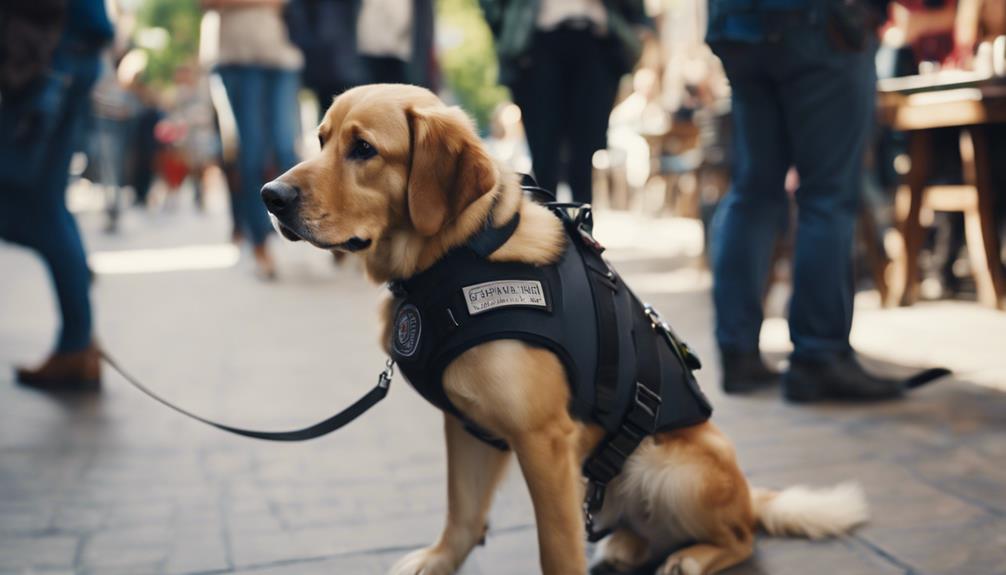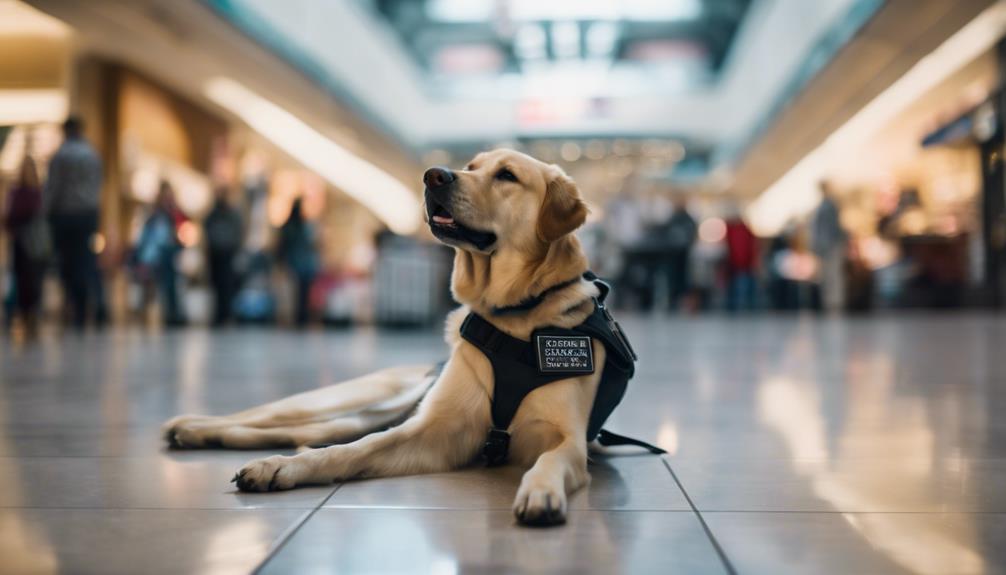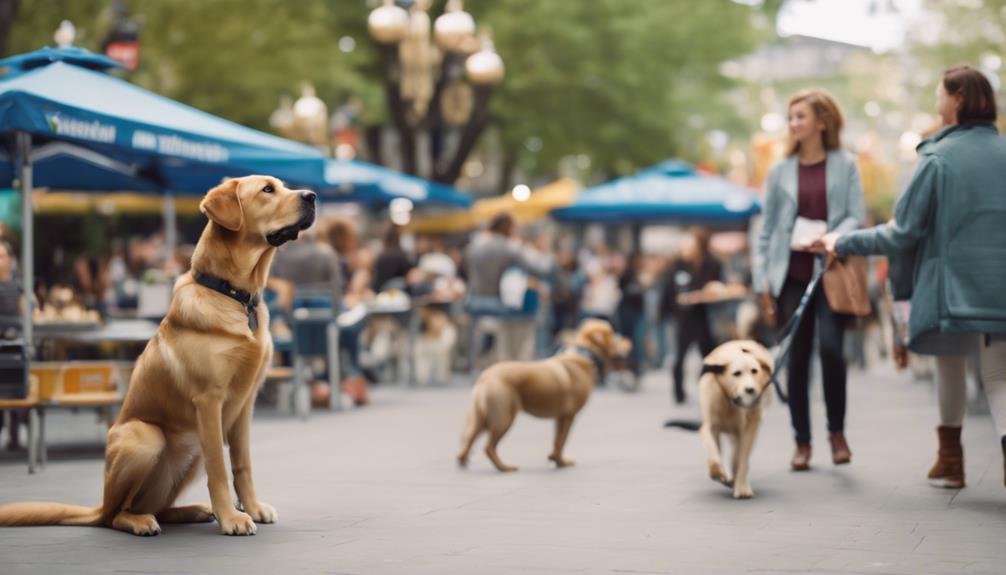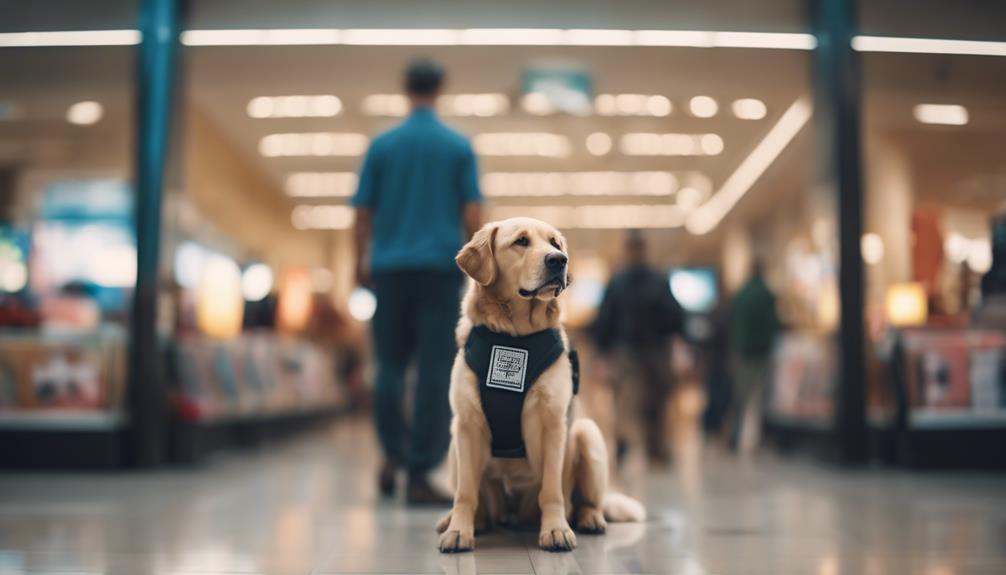Perfecting Service Dog Public Access Training
- Advertisement -
As you work on perfecting your service dog's public access training, remember that rigorous training is key to preparing your dog for the Public Access Test. Aim for a minimum of 120 hours of training over six months, with at least 30 hours focused on outings to prepare your dog to work obediently and unobtrusively in public places. Mastering public access skills requires your dog to remain calm and focused in various environments, ignoring distractions and assisting as needed. By understanding the certification process, training standards, and your role as a handler, you'll be well on your way to perfecting public access training – and that's just the beginning of your journey.
Key Takeaways
- A minimum of 120 hours of rigorous training over six months or more is required for an assistance dog to master public access skills.
- Public access training should focus on teaching specific behaviors through consistent training and positive reinforcement to prepare for real-life situations.
- Breaking down public access training into smaller steps helps focus on specific issues, and gradually increasing exposure to distractions simulates real-life scenarios.
- A service dog handler must be aware of their surroundings, anticipate potential distractions, and intervene promptly to prevent disruptions during public access.
- Certification verifies a service dog's Public Access skills, and finding a reputable certification program that aligns with the dog's needs and training goals is essential.
Understanding Public Access Laws
Understanding Public Access Laws as a Service Dog Owner
As a service dog owner, you have the right to take your dog into public places. However, it's crucial to understand the laws that govern these interactions. The Americans with Disabilities Act (ADA) is a federal law that grants access rights to individuals with disabilities, including those accompanied by a service dog.
The ADA requires service dogs to be well-behaved and under the control of their handlers in public. This means your dog must undergo rigorous training to prepare for the Public Access Test, which evaluates a dog's ability to function in a public setting. Organizations like the Certification Council for Professional Dog Trainers and Assistance Dogs International provide guidelines and resources for service dog teams.
It's essential to understand that the ADA is a law granting access rights, not a certification process. While certification is not required, it's recommended to demonstrate your dog's training and good behavior.
As a service dog team, you represent the entire service dog community. Your actions in public reflect on the community as a whole. By understanding and following public access laws, you can ensure a smooth and respectful interaction in public places.
Remember, public access training is critical to prepare your dog for real-life situations. Many service dog owners also participate in therapy dog training programs and puppy socialization programs to further prepare their dogs for public interactions.
Minimum Training Standards Explained
Minimum Training Standards for Assistance Dogs
A minimum of 120 hours of rigorous training over six months or more is required for an assistance dog to master the skills necessary for successful public access. This extensive training ensures your service dog has the necessary skills to assist you in public settings. At least 30 hours of this training should focus on outings, preparing your dog to work obediently and unobtrusively in public places.
A comprehensive training program should include basic obedience training, advanced task training, puppy socialization, and behavior modification training. Your dog must master basic obedience skills, such as Sit, Stay, Come, Down, Heel, and dropped leash recall. They should also exhibit proper social behavior, including no aggressive behavior, soliciting food or petting, or sniffing merchandise.
In addition, your dog will need to be individually trained to perform specific tasks on command or cue to assist with your disability or needs. The Public Access Certification Test (PACT) evaluates your team's readiness to graduate from an in-training status to a full-fledged assistance dog. This test ensures a consistent level of quality and training across different types of assistance dogs.
The Minimum Training Standards for Public Access are based on Assistance Dogs International (ADI) Minimum Training Standards for Service Dogs. By meeting these standards, you can be confident that your service dog has the necessary skills and behavior to provide you with the assistance you need in public.
Mastering Public Access Skills

Mastering Public Access Skills with Your Service Dog
When you take your service dog into public spaces, it's crucial to master public access skills to ensure a safe and seamless experience for everyone involved. This requires your dog to remain calm and focused in various environments, ignoring distractions and assisting you as needed.
To achieve this, you'll need to teach your dog specific behaviors through consistent training and positive reinforcement. This includes walking by your side, ignoring food and people, and remaining calm around other dogs. Breaking down public access training into smaller steps helps focus on specific issues, and gradually increasing exposure to distractions simulates real-life situations.
As a Service Dog Handler, you must also understand that public access skills involve more than just your dog's behavior. You need to be aware of your surroundings, anticipate potential distractions, and intervene promptly to prevent disruptions. By mastering public access skills, you'll confidently navigate public spaces with your trained service dog, ensuring a safe and enjoyable experience.
The ultimate goal of public access training is to prepare you and your service dog for the Public Access Certification Test. This test evaluates your dog's ability to perform desired behaviors in various public settings. By focusing on mastering public access skills, you'll be well-prepared for certification and can enjoy the many benefits that come with having a well-trained service dog by your side.
Disability-Related Tasks and Training
When developing disability-related tasks and training, create task-specific programs that address your unique needs and disability. This involves designing clear cue commands that your service dog can consistently respond to, and teaching skills that mitigate your specific challenges. Local service dog training programs, such as Advanced Service Dog Training, can provide thorough services to transform animals into valuable companions. Therapy dog training programs can also offer comfort and support in public settings. By doing so, you'll ensure your service dog is equipped to provide the necessary support in various public settings.
Task-Specific Training
Task-specific training is crucial for service dogs to perform specific tasks that mitigate their owner's disability. This type of training builds on basic obedience training, puppy socialization, and behavior modification. It enables dogs to confidently and safely assist their owners in various settings.
Task-specific training is tailored to meet the individual needs of each service dog and owner. The goal is to teach the dog to perform specific tasks or behaviors on command or cue, consistently and reliably, in response to specific situations. This training focuses on the dog's ability to respond to commands in different environments.
For example, a service dog may be trained to alert its owner to certain scents or medical problems. This training ensures the dog can perform the task reliably, even in public places. By investing time and effort into task-specific training, owners can trust their service dogs to perform when it matters most.
Clear Cue Commands
During service dog training, clear cue commands are crucial for disability-related tasks. Consistency is key: using the same verbal cue every time the dog is asked to perform a task helps avoid confusing the dog with mixed signals. Clear cue commands enable the dog to respond accurately and reliably to specific situations.
A task is a specific response to a command or cue. Training should focus on habitually performing this task. The primary way to differentiate between tasks is through clear cue commands, which allows the dog to understand what is expected of them.
Positive Reinforcement Techniques reinforce desired behavior. For service dog training, the minimum level of training required is for the dog to respond reliably to clear cue commands. This training helps build a strong partnership between you and your dog, ensuring they can assist you in various situations.
Disability-Mitigating Skills
Three key areas of disability-mitigating skills are crucial for a service dog to master: navigation, distraction, and support.
To qualify as a service animal, your dog must perform specific tasks that alleviate your disability. For example, teaching your dog to Stay when someone drops something helps you maintain balance and prevents accidents. Effective leash training and socialization, including recall training, are vital for navigating public spaces confidently. Understanding canine body language is also essential for recognizing emotional cues and responding appropriately.
As a service dog handler, you must ensure your dog is fully trained to navigate public spaces, ignoring distractions and providing emotional support when needed. Meeting the Minimum Training Standards is essential, and passing the Canine Good Citizen test is a good starting point. Once your dog is trained, you can obtain a certification ID from specific organizations, often requiring a laminated photo ID Card.
Trainer's Responsibilities and Certification

As a service dog trainer, you'll be responsible for several key tasks. First, you'll need to stay up-to-date on relevant laws and prioritize the dog's well-being. This includes using humane training methods and monitoring the dog's stress levels. You'll also need to maintain a professional image at all times.
Many service dog training programs, including Advanced Service Dog Training, require trainers to be familiar with various tasks and skills that service dogs perform. While certification is not required in the USA, it can demonstrate your expertise and commitment to providing high-quality training.
Trainer's Role
As a trainer, you play a crucial role in ensuring your service dog's smooth integration into public spaces. You must be knowledgeable about relevant laws and regulations regarding service dogs. Additionally, you are responsible for your dog's health, grooming, and well-being.
When training your dog, use humane methods that monitor stress levels and provide regular breaks to prevent exhaustion. Positive reinforcement techniques, such as reward-based training, motivate your dog to learn and associate desired behaviors with positive outcomes.
As an ambassador for service dogs, you must demonstrate respect and consideration for others. Carry clean-up materials with you and arrange for prompt clean-up if your dog eliminates or gets sick in public. This shows responsibility and respect for others.
Be prepared to educate the public about service dogs and access rights. Promote understanding and acceptance by being polite and willing to answer questions. Your goal is to ensure your service dog has hassle-free public access, and you play a key role in making that happen. By fulfilling your responsibilities, you contribute to a positive image of service dogs and their trainers, ultimately helping to protect access rights for all.
Certification Importance
Certification is a crucial step in verifying your service dog's Public Access skills. As a trainer, it's your responsibility to find a certification program that assesses your dog's readiness for public access.
To choose a certification program, look for one that meets your specific needs. Ensure the program is reputable and offers thorough services.
To achieve certification, follow these steps:
- Advertisement -
- Enroll in a reputable certification program that aligns with your service dog's needs and your training goals.
- Meet the program's eligibility requirements, which may include age, training level, and documentation.
- Pass the program's testing and evaluation process, which may include simulated public access scenarios.
- Obtain a certification ID, which serves as proof of your service dog's Public Access skills.
Certification is important because it enhances your service dog's credibility and provides assurance to the public that your dog is well-trained and capable of navigating various environments.
Preparing for the Public Access Test
Preparing for the Public Access Test requires a structured plan and dedication to training. To ensure your service dog is ready, aim for a minimum of 120 hours of training over six months or more. At least 30 hours should focus on public outings, such as visits to stores, restaurants, and public transportation, to help your dog learn to work obediently in these environments.
Incorporating therapy dog training principles can help your dog become more confident in public. Puppy socialization is also crucial in preparing your dog for the test. Mastering basic obedience skills is essential to passing the Public Access Test. Your service dog must consistently execute commands like Sit, Stay, Come, Down, Heel, and dropped leash recall.
Practice these skills in various public settings and scenarios, focusing on clear communication and consistent cues. This helps your dog generalize their learning and respond correctly in different situations. The Public Access Test evaluates your team's readiness to graduate from an in-training status to a full-fledged assistance dog. It assesses your team's performance, not the disability mitigating tasks or work.
To guarantee success, dedicate time and effort to thorough training and practice. This ensures you and your service dog are well-prepared for the test and ready to provide essential support to those in need.
Overcoming Common Training Challenges

During service dog training, challenges are inevitable. Distractions, obedience issues, and socialization difficulties can hinder progress and test your patience. To address these challenges, it's crucial to understand canine communication, body language, and behavior. This helps identify underlying emotional needs, such as anxiety or excitement, and prevent issues like leash pulling.
To overcome these challenges, use the following strategies:
- Desensitize your dog to stimuli by gradually exposing them to loud noises, people, and objects. This helps them remain calm and focused in public.
- Practice leash control by training your dog to walk on a leash without pulling. Also, practice control from a distance without a leash to simulate real-life scenarios.
- Socialize your dog extensively by exposing them to new environments, people, and experiences. This builds confidence and calmness in public.
- Reinforce obedience training by regularly practicing commands like "sit," "stay," and "leave it." This ensures your dog responds promptly and reliably in public.
Building Confidence in Public Spaces
Building Confidence in Public Spaces with Your Service Dog
When taking your service dog into public spaces, it's crucial to build their confidence in these environments. A confident service dog can better assist you in various situations, ensuring your safety and comfort.
To achieve this, your trainer will create a customized training plan that addresses your dog's specific needs and goals. Consistency in verbal cues, tone, and rewards is vital for effective communication and trust-building, especially in distracting public environments. This consistency builds trust and strengthens the bond between dog and trainer, essential for successful public access training.
To build confidence, start with short training sessions in quiet areas, gradually increasing the duration and distractions. Desensitize your dog to common public access obstacles, such as loud noises, people, and objects. Practice obedience exercises like "sit" and "stay" in different locations to reinforce good behavior. As a handler, it's essential to remain calm and assertive in public.
As you progress, incorporate real-life scenarios into your training, such as navigating through crowds or riding public transportation. A well-trained service dog should maintain focus on you despite surrounding distractions. Remember, consistency and patience are key to building confidence.
Your trainer will provide guidance and support throughout the process, helping you and your dog become a cohesive team. By investing time and effort into public access training, you'll be able to certify your service dog and test their skills in various environments, ultimately strengthening your bond and confidence in public spaces.
Achieving Successful PAT Certification

Achieving Successful PAT Certification
PAT certification is the next step after building your service dog's confidence in public spaces. This certification assesses your team's readiness to graduate from an in-training status to a full-fledged assistance dog. It evaluates your performance, not the disability-mitigating tasks or work.
To prepare for the PAT evaluation, practice in various public settings and scenarios. Focus on clear communication and consistent cues, desensitizing your dog to distractions and noises, and practicing maneuvering obstacles and tight spaces. Socialization is crucial for a dog's emotional and psychological development. Expose your dog to various environments, people, and situations, starting early when they're young.
Certification requires periodic re-evaluation to validate continued proficiency. Teams need to adhere to recertification schedules and guidelines, and engage in ongoing training and practice to maintain their skills and bond.
The PAT evaluation assesses your team's ability to navigate 12-15 public access scenarios, including basic obedience, distractions, and interactions. Evaluators evaluate your dog's behavior, obedience, and focus, as well as your skills, confidence, and communication.
To prepare, follow these steps:
Practice in diverse settings to validate your dog's comfort and focus in different environments.
Master clear communication by developing consistent cues and commands.
Desensitize your dog to distractions, such as loud noises, children, and other animals, to improve their focus and obedience.
Stay up-to-date with recertification schedules and guidelines to maintain your team's certification and validate continued proficiency.
Frequently Asked Questions
How Many Commands Must a Dog Learn to Be a Service Dog?
To become a service dog, a dog must learn a minimum of 30 commands. These commands cover basic obedience, such as "sit" and "stay," as well as advanced tasks that address specific disability needs. The exact number of commands may vary depending on the certification organization.
Clarity and consistency are essential in training. You'll need to dedicate time to training, focusing on task specificity, distraction proofing, and positive reinforcement methods. This ensures your dog excels in public access training.
What Are the Three Questions You Can Ask About a Service Dog?
When interacting with a service dog, you are allowed to ask three specific questions. These questions help you demonstrate respect for the individual and their canine companion while supporting public access awareness and disability rights.
The three questions you can ask are:
- Is this a service dog?
- What task has the dog been trained to perform?
- Do you have proof of vaccination?
Asking these questions shows you care about the importance of trained professionals and legal protections. Remember, it's essential to respect the individual's privacy and not ask personal questions about their disability.
Why Do Dogs Fail Service Training?
Dogs fail service training due to various reasons. One common cause is underlying issues, such as a lack of confidence, fearful reactions, or high anxiety. Some dogs may have genetic predispositions that make them unsuitable for service work. Poor breeding and inadequate socialization can also contribute to failure.
In addition, external factors can hinder a dog's ability to succeed. These include insufficient exercise, unstable environments, and overwhelming stimuli. Unrealistic expectations from trainers or owners can further complicate the issue.
To improve the chances of success, it's essential to identify and address these potential roadblocks. By doing so, you can provide a more suitable environment for your dog to thrive.
How to Train Your Dog to Behave in Stores?
Training your dog to behave in stores requires teaching specific skills. Start by focusing on basic store etiquette, including calm walking, quiet shopping, and polite greetings. Once your dog has mastered these skills, move on to more advanced training. This includes teaching your dog to refuse food, navigate shopping carts, and be aware of their surroundings in store aisles. Additionally, practice patience during checkout, resistance to distractions, and attention to floor hazards. With consistent practice, your dog will learn to behave well in stores.
In summary
Perfecting public access training with your service dog takes time and effort, but the payoff is substantial. With a well-trained service dog, you can confidently navigate public spaces, knowing that your dog will behave appropriately in any situation. This training is crucial, as it allows you to access essential services, travel, and participate in social activities without worrying about your dog's behavior.
To achieve this level of trust and reliability, you've invested time and practice in training your service dog. You've learned how to handle common distractions, manage your dog's behavior in crowded areas, and respond to unexpected situations. Your hard work has earned you PAT certification, which is a testament to your dog's good behavior in public.
Now, you can enjoy greater freedom and independence, knowing that your service dog is a well-behaved and trusted companion. You can focus on living your life, without worrying about your dog's behavior holding you back.
- Advertisement -

